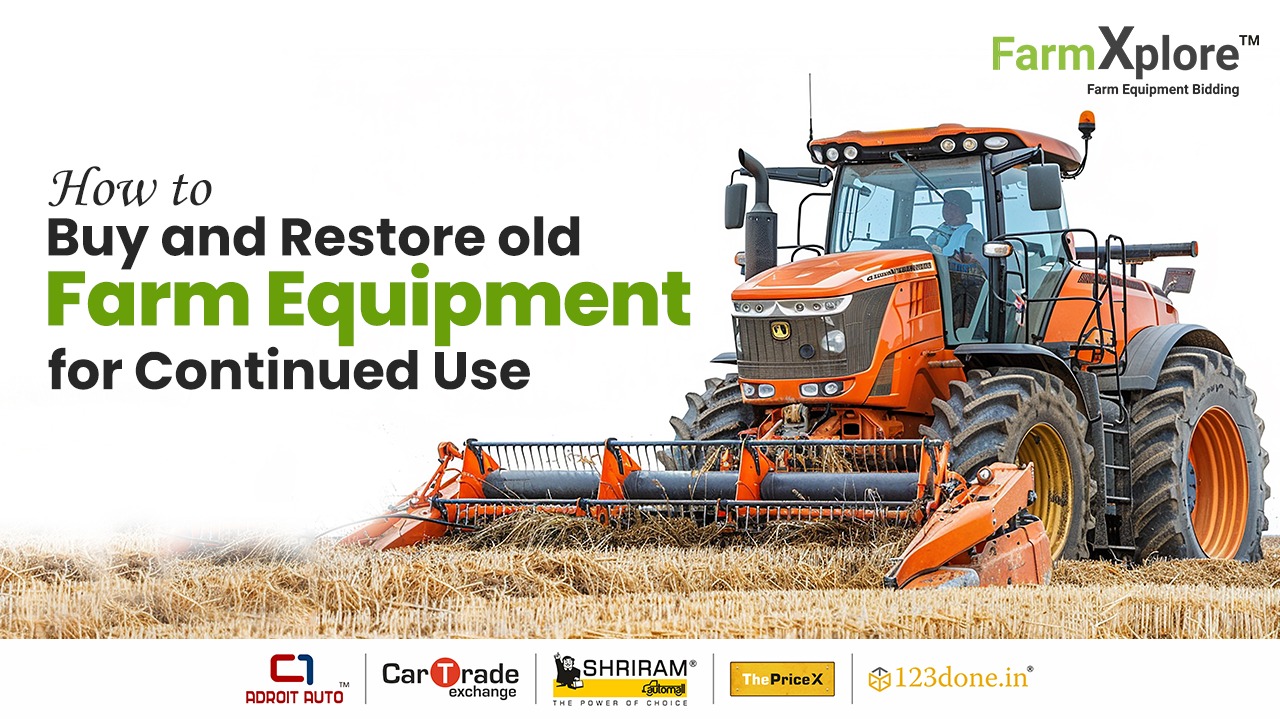Guide to Buying and Restoring Old Farm Equipment

Buying new farm equipment can be prohibitively expensive compared to buying and restoring old farm equipment. This provides an affordable and sustainable alternative to the farmers and a chance to bring durable, well-structured machinery back to life. In this blog, we’ll learn the steps involved in buying an old farm equipment for continued use and restoring process. From assessing quality to sourcing parts, Shriram Automall India Limited, India’s Largest Phygital Marketplace for Pre-owned Vehicles & Equipment can help you to find an ideal farm equipment through its unique bidding platforms.
Why Buy Old Farm Equipment?
Old farm equipment is highly valued for its durability, simplicity, and affordability. Many older farm-machines were built to last, with solid materials and fewer complex electronics compared to newer models. It offers several advantages for small-scale farmers as follow:
Cost-effective
At less expensive price, purchasing old farm equipment can give you a peace of mind. You can find old farm equipment through bidding auctions and dealerships.
- Durability: Older farm equipment is often built with higher quality and durability, designed to withstand harsh working conditions.
- Easy to Repair: Because older machinery typically has fewer complex electronic components, repairs are often simpler and can be handled by farmers themselves with the right knowledge.
However, not all old farm equipment gives a worthful value to the farmers. It depends on the process knowledge of assessing, restoring and maintaining an old farm equipment that provides a good resale value in future.
Finding the Right Equipment: Auctions, Dealers, and Listings
Before diving into restoration, farmers need to know the right place to buy well-equipped equipment. Know the ways to source the old farm equipment:
- Farm Equipment Auctions: Local farm equipment auctions, both physical and online, are excellent places to find old machinery. Sites like Shriram Automall India Limited and other auction platforms offer a wide variety of old farm equipment at competitive prices. It's important to carefully read the descriptions and conditions of inner and external vehicle parts, as some may require significant repairs.
- Dealers and Classified Listings: Purchasing through different channels like old farm equipment dealers and listings in local newspapers or online platforms like Craigslist or Facebook Marketplace, its significant to meet the seller and inspect the equipment in-person to avoid hidden damages or any other problems later.
- Word of Mouth: Most of the times, best deals come from personal and local farming community.
Assessing the Condition of Old Equipment
Once you’ve located a potential purchase, it’s critical to thoroughly inspect the old farm equipment to avoid buying something beyond repair. Here are a few key areas to focus on:
- Mechanical Condition: Look at the engine, transmission, hydraulics, and other mechanical components. Is the equipmeacnt running, or will you need to rebuild the engine or replace major parts? Some rust and wear are to be expected, but significant structural issues could make expensive repairs.
- Operational Check: If possible, test the equipment to see if it operates smoothly. Listen for unusual sounds, check the fluid levels, and test the hydraulics, steering, and brakes.
- Parts Availability: Check if replacement parts such as piston, crankshaft, cylinder head, manifold, oil pan, engine block, valves, and manifolds are readily available. During inspection, its crucial to check some old model parts that are no longer in production, which can complicate restoration efforts.
- Rust and Structural Integrity: Surface rust is usually not a major issue, but deep rust can weaken the frame or other critical components. Ensure that the frame and any major structural components are intact.
3. Planning the Restoration Process
Once you’ve purchased your farm equipment, it’s time to start planning the restoration. Restoration projects can vary significantly in terms of complexity and cost, depending on the condition of the equipment. Consider the following steps to get started:
- Set a Budget: Before making the big investment, ensure small steps are effectively taken. Deciding a budget is one of the most crucial steps in restoration process, checking the willingness to spend on parts, labor and other costs involved in the restoration so that you make a wise investment lower than the cost.
- Create a Timeline: Restoration can take weeks or even months depending on the scope of the project. Plan your timeline to ensure you can get the equipment up and running when needed for your farming activities.
- Source Replacement Parts: Identify any parts that need to be replaced. You can often find parts through online marketplaces, salvage yards, or specialized farm equipment dealers. In some cases, custom parts may need to be fabricated.
Steps to Restore Old Farm Equipment
Once your plan is ready, it's time to get to implement on the restoration itself. Here are the general steps to follow:
a. Cleaning the Old Equipment
Thoroughly clean the equipment to remove rust, dirt, and grime before starting the repairs. To make it easier to inspect and repair each part, strip it down to basic components. Pressure washing and the use of rust removal chemicals can help in cleaning.
b. Repairing or Rebuilding the Engine
If the engine is not functioning or needs improvement, this should be the first priority in the restoration process. Some repairs may require replacing pistons, cylinders, or other engine components. If the engine is beyond repair, consider replacing it entirely or rebuilding it with salvaged parts.
c. Fixing or Replacing Hydraulics
Many pieces of old farm equipment rely on hydraulic systems. Inspect hoses, pumps, and cylinders for leaks or wear. Replace any worn-out seals or hoses and ensure that the hydraulic system is functioning correctly.
d. Electrical Systems and Wiring
If the equipment has an electrical system, check the wiring and any battery connections. Old wiring can become brittle and may need to be completely replaced. Install new switches, lights, or other electrical components as needed.
e. Painting and Finishing
After completing mechanical and structural repairs, repainting the equipment will help protect it from rust and further wear. Choose a durable paint designed for outdoor use, as this will provide the best protection against the elements.
Maintaining Restored Equipment for Continued Use
Once your equipment is restored, regular maintenance is essential to ensure its longevity and continued performance. Here’s how to keep it running smoothly:
- Routine Inspections: After each use, inspect the equipment for signs of wear and tear. Address minor issues immediately to avoid more extensive repairs down the line.
- Lubrication and Fluids: Keep all moving parts well-lubricated, and regularly check fluid levels. Change oil, hydraulic fluids, and filters as needed.
- Storage: Store equipment in a covered area or shed to protect it from the elements. Rust is a major enemy of old farm equipment, so keep it dry and out of harsh weather conditions.
- Servicing: Set a schedule for servicing your equipment based on usage. Regularly checking on belts, hoses, and hydraulics ensures that the equipment stays in good working condition for years.
Conclusion
Buying and restoring old farm equipment is a cost-effective and rewarding option for many small-scale and large-scale farmers. By carefully selecting, inspecting, and restoring old machinery, you can enjoy the benefits of durable and reliable equipment at affordable prices, making electronic components usage easier compared to new models. Regular maintenance after restoration ensures that your old equipment will continue to serve you long-lasting.
Whether you’re attending an auction or browsing listings online, keep these steps in mind to make informed decisions and get the most out of your investment. Also, Shriram Automall helps you find a perfect old farm equipment through its unique omni-present platforms. So, you can visit our automalls in-person or become part of live bidding at 135+ locations Pan-India, check the latest inventory of Old Cars ensuring you a seamless and convenient customer experience.
Other Related Articles:

 Download Our App
Download Our App



